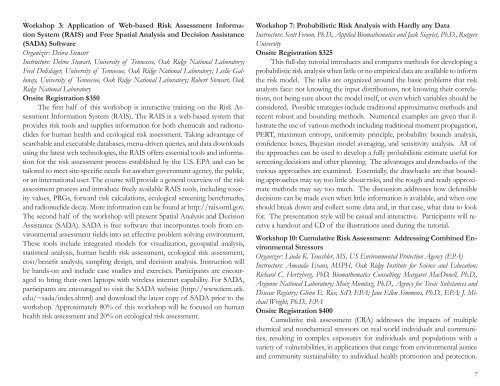Risk Analysis: Advancing Analysis - The Society for Risk Analysis
Risk Analysis: Advancing Analysis - The Society for Risk Analysis
Risk Analysis: Advancing Analysis - The Society for Risk Analysis
You also want an ePaper? Increase the reach of your titles
YUMPU automatically turns print PDFs into web optimized ePapers that Google loves.
Workshop 3: Application of Web-based <strong>Risk</strong> Assessment In<strong>for</strong>mation<br />
System (RAIS) and Free Spatial <strong>Analysis</strong> and Decision Assistance<br />
(SADA) Software<br />
Organizer: Debra Stewart<br />
Instructors: Debra Stewart, University of Tennessee, Oak Ridge National Laboratory;<br />
Fred Dolislager, University of Tennessee, Oak Ridge National Laboratory; Leslie Galloway,<br />
University of Tennessee, Oak Ridge National Laboratory; Robert Stewart, Oak<br />
Ridge National Laboratory<br />
Onsite Registration $350<br />
<strong>The</strong> first half of this workshop is interactive training on the <strong>Risk</strong> Assessment<br />
In<strong>for</strong>mation System (RAIS). <strong>The</strong> RAIS is a web-based system that<br />
provides risk tools and supplies in<strong>for</strong>mation <strong>for</strong> both chemicals and radionuclides<br />
<strong>for</strong> human health and ecological risk assessment. Taking advantage of<br />
searchable and executable databases, menu-driven queries, and data downloads<br />
using the latest web technologies, the RAIS offers essential tools and in<strong>for</strong>mation<br />
<strong>for</strong> the risk assessment process established by the U.S. EPA and can be<br />
tailored to meet site-specific needs <strong>for</strong> another government agency, the public,<br />
or an international user. <strong>The</strong> course will provide a general overview of the risk<br />
assessment process and introduce freely available RAIS tools, including toxicity<br />
values, PRGs, <strong>for</strong>ward risk calculations, ecological screening benchmarks,<br />
and radionuclide decay. More in<strong>for</strong>mation can be found at http://rais.ornl.gov.<br />
<strong>The</strong> second half of the workshop will present Spatial <strong>Analysis</strong> and Decision<br />
Assistance (SADA). SADA is free software that incorporates tools from environmental<br />
assessment fields into an effective problem solving environment.<br />
<strong>The</strong>se tools include integrated models <strong>for</strong> visualization, geospatial analysis,<br />
statistical analysis, human health risk assessment, ecological risk assessment,<br />
cost/benefit analysis, sampling design, and decision analysis. Instruction will<br />
be hands-on and include case studies and exercises. Participants are encouraged<br />
to bring their own laptops with wireless internet capability. For SADA,<br />
participants are encouraged to visit the SADA website (http://www.tiem.utk.<br />
edu/~sada/index.shtml) and download the latest copy of SADA prior to the<br />
workshop. Approximately 80% of this workshop will be focused on human<br />
health risk assessment and 20% on ecological risk assessment.<br />
Workshop 7: Probabilistic <strong>Risk</strong> <strong>Analysis</strong> with Hardly any Data<br />
Instructors: Scott Ferson, Ph.D., Applied Biomathematics and Jack Siegrist, Ph.D., Rutgers<br />
University<br />
Onsite Registration $325<br />
This full-day tutorial introduces and compares methods <strong>for</strong> developing a<br />
probabilistic risk analysis when little or no empirical data are available to in<strong>for</strong>m<br />
the risk model. <strong>The</strong> talks are organized around the basic problems that risk<br />
analysts face: not knowing the input distributions, not knowing their correlations,<br />
not being sure about the model itself, or even which variables should be<br />
considered. Possible strategies include traditional approximative methods and<br />
recent robust and bounding methods. Numerical examples are given that illustrate<br />
the use of various methods including traditional moment propagation,<br />
PERT, maximum entropy, uni<strong>for</strong>mity principle, probability bounds analysis,<br />
confidence boxes, Bayesian model averaging, and sensitivity analysis. All of<br />
the approaches can be used to develop a fully probabilistic estimate useful <strong>for</strong><br />
screening decisions and other planning. <strong>The</strong> advantages and drawbacks of the<br />
various approaches are examined. Essentially, the drawbacks are that bounding<br />
approaches may say too little about risks, and the rough and ready approximate<br />
methods may say too much. <strong>The</strong> discussion addresses how defensible<br />
decisions can be made even when little in<strong>for</strong>mation is available, and when one<br />
should break down and collect some data and, in that case, what data to look<br />
<strong>for</strong>. <strong>The</strong> presentation style will be casual and interactive. Participants will receive<br />
a handout and CD of the illustrations used during the tutorial.<br />
Workshop 10: Cumulative <strong>Risk</strong> Assessment: Addressing Combined Environmental<br />
Stressors<br />
Organizer: Linda K. Teuschler, MS, US Environmental Protection Agency (EPA)<br />
Instructors: Amanda Evans, MSPH, Oak Ridge Institute <strong>for</strong> Science and Education;<br />
Richard C. Hertzberg, PhD, Biomathematics Consulting; Margaret MacDonell, Ph.D.,<br />
Argonne National Laboratory; Moiz Mumtaz, Ph.D., Agency <strong>for</strong> Toxic Substances and<br />
Disease Registry; Glenn E. Rice, ScD, EPA; Jane Ellen Simmons, Ph.D., EPA; J. Michael<br />
Wright, Ph.D., EPA<br />
Onsite Registration $400<br />
Cumulative risk assessment (CRA) addresses the impacts of multiple<br />
chemical and nonchemical stressors on real world individuals and communities,<br />
resulting in complex exposures <strong>for</strong> individuals and populations with a<br />
variety of vulnerabilities, in applications that range from environmental justice<br />
and community sustainability to individual health promotion and protection.<br />
7
















